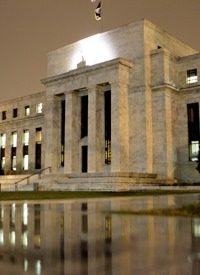
In other words, the Board had a BFO (blinding flash of the obvious) and finally had to come clean and admit that after two years of trying to stimulate the patient back to health, nothing has worked, and the patient is getting sicker.
Analysts got excited at the slight change in the wording of the report, that stimulus in the form of low interest rates will remain, not for the “extended period” mentioned in earlier reports, but for “at least through mid-2013.” The remedies — some $2.3 trillion under President Bush’s Quantitative Easing I and Quantitative Easing II under President Obama — that haven’t worked are going to continue to be applied to the patient. Hidden at the end of the report was the ominous portent of that additional stimulus to come: “The Committee discussed the range of policy tools available to promote a strong economic recovery.” (Emphasis added.)
What tools? The Fed has only two tools at its disposal: the microphone, provided always by the compliant and ever-supportive media, and the printing press. And the cheerleaders were vocal in their support of the impending QE3: Randall Kroszner, professor at the University of Chicago, said, “The chairman will do the right thing for the economy regardless of what people might say.”
Back in March, Lew Rockwell first predicted QE3 while the second round of failed stimulus was still in operation. Rockwell reminded his readers that when Bernanke was asked about the possibility of further stimulus after the second round ended in June, he responded:
In the end, we’ll just ask the same questions. Where’s the economy going, and what do various inflation indicators look like? We’ll ask those questions. If unemployment is still too [high], then we may continue. If we’re moving towards full employment, then we won’t need to stimulate more.
Rockwell was chagrined at Bernanke’s continued attempts to improve the economy, knowing full well the failed results of the past interventions: “History is littered with monetary managers who believed they were in total control, until the disaster they caused hit. It is hubris of the first order to believe themselves to be masters of the universe — but hubris is epidemic in Washington.”
The reason why previous attempts to revive, resuscitate, resurrect, and restore the economy have failed is due to the continued misunderstanding of how the economy works. Economic stimulus efforts are like a drug addict being injected with heroin — at first, there is a predictable “high,” followed by a crash. To recover from the crash, additional heroin is administered, but the effect of the second, and following doses, doesn’t match the first. The alternative — overcoming the addiction by withdrawal and going “cold turkey” — isn’t even considered. As Rockwell explains:
These various attempts to restore the [addict’s] happy time have unpredictable and uncontrollable effects, and the metaphor helps here, too. The body is weakened. It might take more of the drug to get the same effect. The drug promotes the underlying disease. Each new dose makes the [patient] ever less rational and coherent.
Bill Bonner, author of Financial Reckoning Day made a prescient call back in May when he told his readers what to expect: “The Fed will announce new measures — QE3. These could come any time, but will most likely follow a new crisis. For example, a default by Greece … or a sharp break in the stock market." (Emphasis added.)
Peter Schiff joined the predictors in July when he noted that he “had been forecasting with near certainty that QE2 would not be the end of the Fed’s money-printing program,” but with little positive effect expected. He added, “Fighting a recession with QE is like fighting a fire with gasoline. As the flames of recession reignite, more QE, while dousing it momentarily, will only produce an even larger economic inferno.”
Bernanke’s options are indeed limited. John Makin, an economist with the American Enterprise Institute, said,
It seems we’ve thrown everything at it. We’ve had QE1 and QE2, Stimulus 1 and Stimulus 2, and the unemployment rate is still 9.1 percent. Maybe there are just not many options [left] at this point.
The only remedy that has any chance of working is "less, not more." Or in the words of Henry Hazlett: “Stop the remedies!” Let the bankrupt go bankrupt. Let the housing market clear itself. Turn off the printing press. Adopt a little humility and let sanity reign once again.
Photo of the Federal Reserve: AP Images



